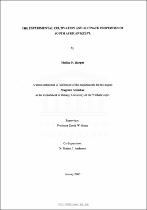| dc.contributor.advisor | Keats, Derek W. | |
| dc.contributor.advisor | Anderson, Robert J. | |
| dc.contributor.author | Harper, Mellisa N | |
| dc.date.accessioned | 2023-06-20T07:02:26Z | |
| dc.date.available | 2023-06-20T07:02:26Z | |
| dc.date.issued | 2003 | |
| dc.identifier.uri | http://hdl.handle.net/11394/10294 | |
| dc.description | Magister Scientiae (Biodiversity and Conservation Biology) | en_US |
| dc.description.abstract | Alginates are used in various industries and the quality of alginates used must be controlled. Alginates used for medical purposes must be of a very high quality. The cost of obtaining high-quality alginate is high and very time-consuming. A simple procedure is described for the purification and extraction of alginate from the kelp Laminaria pallida. The kelp was divided into different sections, including the blades. The stipes were cleaned and some were peeled and extractions were made of all the different sections including the peels. Analysis of the purified alginate showed a protein content below detectable levels and a very low polyphenol content. The purified alginate was
highly viscous, with24 - 29 centipoise for a0.l %o solution. Using this method a higher quality alginate can be obtained from any section of the kelp and this will help in more medical advances | en_US |
| dc.language.iso | en | en_US |
| dc.publisher | University of the Western Cape | en_US |
| dc.subject | Alginate | en_US |
| dc.subject | Extraction | en_US |
| dc.subject | Laminaria pallida | en_US |
| dc.subject | phenols | en_US |
| dc.subject | Viscosity | en_US |
| dc.title | The experimental cultivation and alginate properties of South African kelps | en_US |
| dc.rights.holder | University of the Western Cape | en_US |

